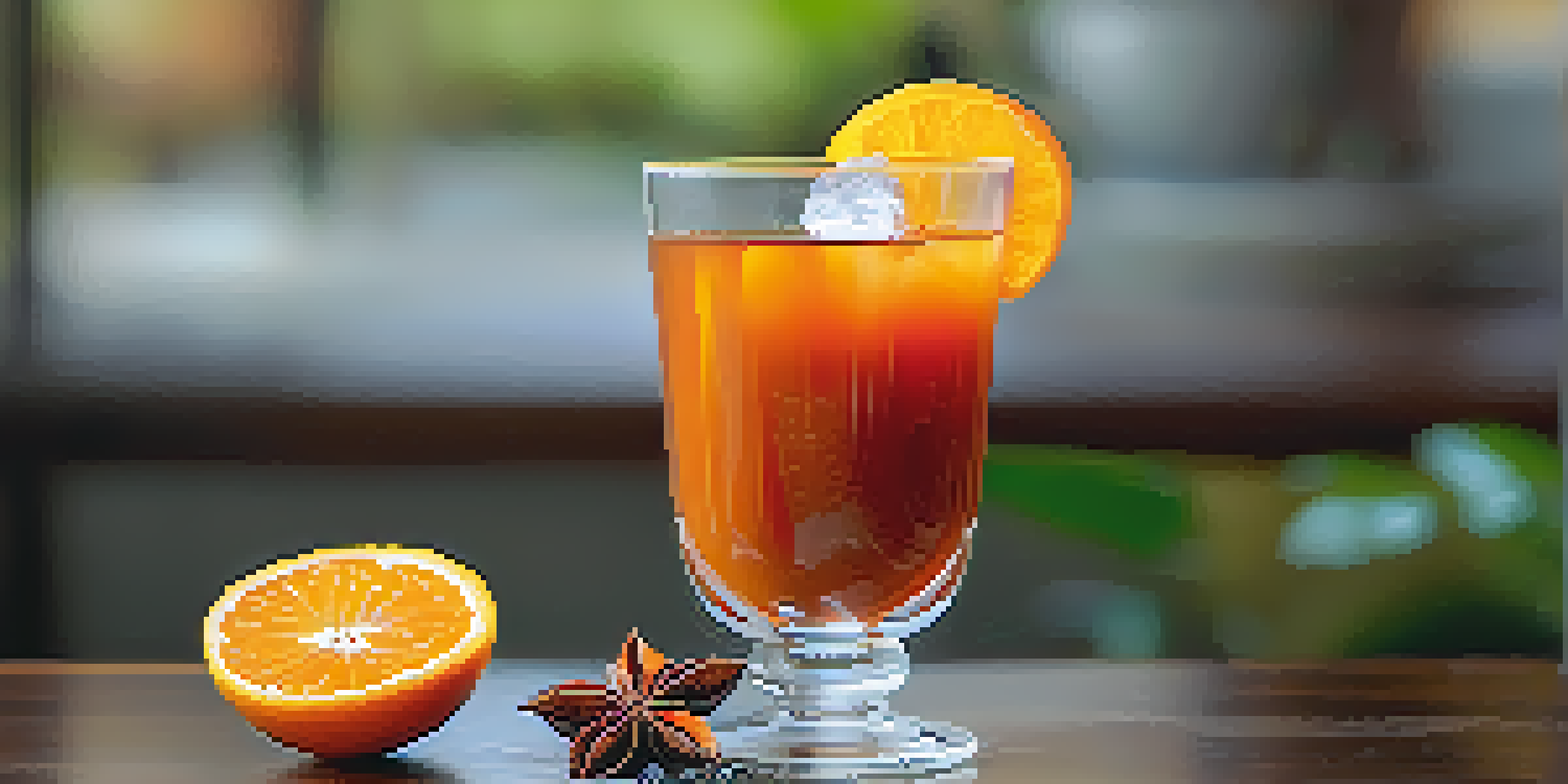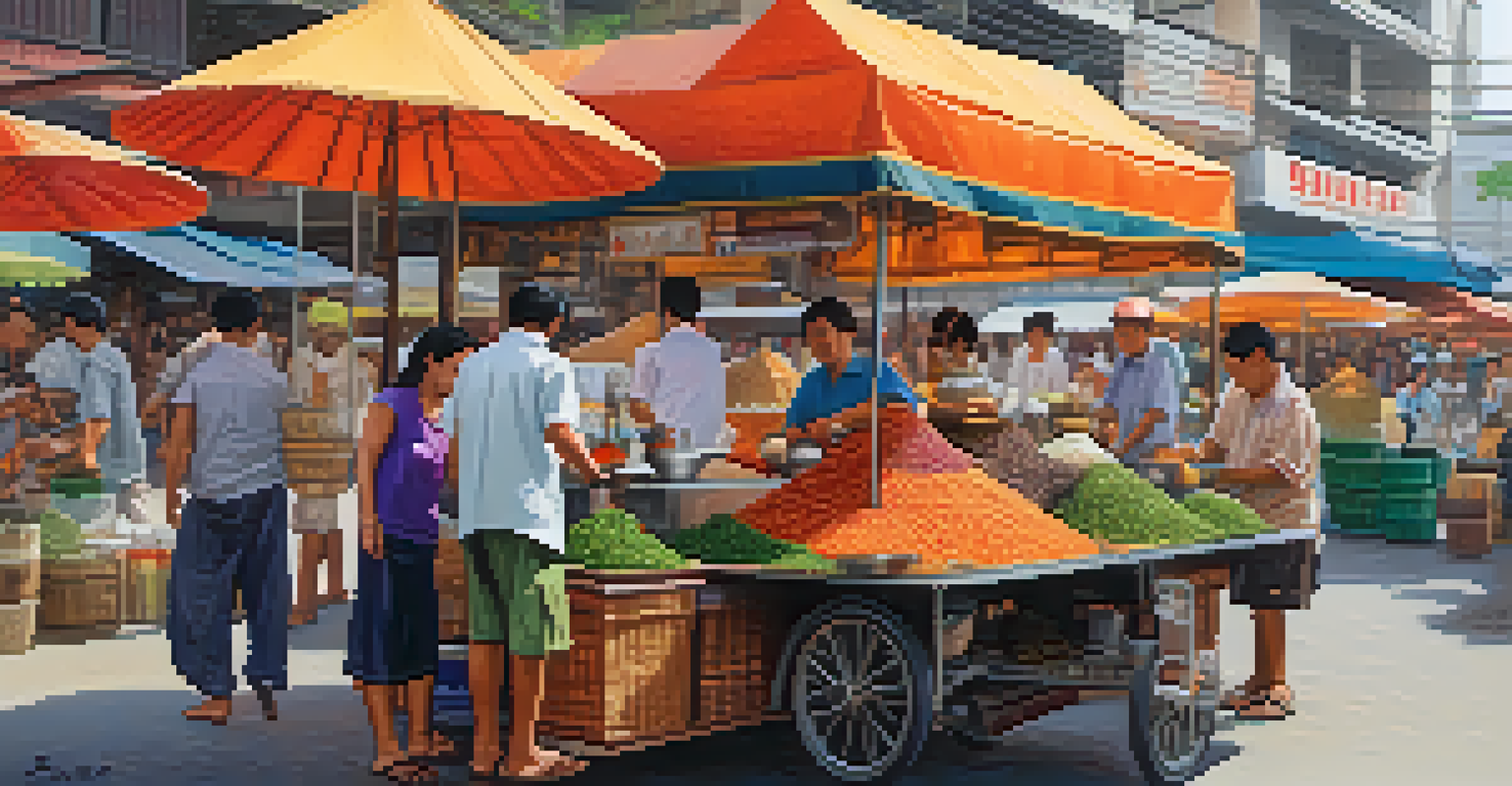Exploring the Origins of Traditional Thai Tea and Its Rituals

The Roots of Traditional Thai Tea: A Historical Overview
Thai tea, known for its robust flavor and vibrant orange color, has a fascinating history that dates back centuries. Its origins can be traced to the influence of Chinese tea culture, which made its way to Thailand through trade routes. Over time, local farmers began cultivating their own varieties, leading to the unique blend we enjoy today.
Tea is the magic key to the vault where my brain is kept.
The tea is primarily made from Ceylon tea leaves, which are known for their strong, aromatic qualities. This blend is often combined with spices such as star anise and tamarind, creating a distinctive flavor profile. As tea culture blossomed in Thailand, it became a staple in both everyday life and special occasions.
Through the years, Thai tea has evolved, with influences from cultures both within and outside Thailand. It serves not only as a refreshing beverage but also as a connection to the nation’s rich heritage, symbolizing hospitality and warmth in Thai society.
The Ingredients: What Makes Thai Tea Unique?
At the heart of traditional Thai tea is the unique combination of ingredients that sets it apart from other types of tea. The primary ingredient, Ceylon tea, is often mixed with sweetened condensed milk, which gives it a creamy texture and enhances its flavor. The addition of sugar and sometimes spices makes it a delightful treat.

Another key component is the use of vibrant orange food coloring, which not only adds visual appeal but also signifies the indulgent nature of this beverage. The color has become synonymous with Thai tea, making it instantly recognizable to tea lovers around the world.
Thai Tea's Rich Historical Roots
Thai tea's origins stem from Chinese tea culture, evolving through local cultivation and blending over centuries.
These ingredients together create a balance of sweetness, creaminess, and spiced notes that tantalize the taste buds. This unique fusion is what keeps both locals and tourists returning for more, ensuring that the tradition continues to thrive.
The Cultural Significance of Thai Tea in Daily Life
In Thailand, tea is more than just a drink; it’s an integral part of daily life and social interactions. Street vendors and cafes serve Thai tea throughout the day, making it a popular refreshment for locals and tourists alike. It's common to see friends gathering over a glass, sharing stories and laughter.
There is something in the nature of tea that leads us into a world of quiet contemplation of life.
Thai tea also plays a role in traditional ceremonies and celebrations. For instance, it's often served during weddings and festivals, symbolizing unity and joy. Its presence at such events highlights the beverage's importance in Thai culture and the value placed on communal experiences.
Moreover, the act of brewing and serving tea is often viewed as a ritual of hospitality. Offering a glass of Thai tea to guests is a warm gesture that reflects the Thai values of kindness and generosity, making it a cherished element of social gatherings.
Brewing the Perfect Cup: Traditional Methods
Brewing traditional Thai tea is a skill that many locals take pride in mastering. The process typically begins with boiling water and steeping the Ceylon tea leaves until they reach a rich, dark color. The art of brewing lies in timing and temperature, ensuring that the flavor is extracted without becoming overly bitter.
Once brewed, the tea is often strained to remove the leaves, creating a smooth base for the next steps. At this point, sugar and condensed milk are added, creating a sweet and creamy mixture that is both refreshing and indulgent. This method is simple yet requires practice to perfect.
Cultural Significance in Thailand
In Thailand, Thai tea is central to social interactions and ceremonial gatherings, symbolizing hospitality and community.
Serving the tea over ice is a popular way to enjoy it, especially in Thailand's tropical climate. The ritual of preparing and serving Thai tea can be a beautiful experience, inviting the drinker to appreciate the flavors and the cultural significance behind each sip.
Exploring Thai Tea Variations Around the World
As Thai tea gained popularity beyond Thailand, various adaptations emerged, reflecting local tastes and preferences. In places like the United States and Europe, you might find Thai tea served in different styles, such as bubble tea or lattes. These variations often incorporate additional flavors or textures, appealing to a broader audience.
Some cafes experiment with plant-based milks or reduced sugar options to cater to health-conscious consumers. While these variations maintain the essence of traditional Thai tea, they also highlight how the beverage can evolve while still honoring its roots.
This global adaptation has helped introduce more people to the unique flavors of Thai tea, fostering a greater appreciation for its origins and cultural significance. Whether enjoyed in its traditional form or as a modern twist, Thai tea continues to delight palates worldwide.
The Rituals of Enjoying Thai Tea: A Social Experience
The experience of enjoying Thai tea often transcends the act of drinking; it becomes a ritual that brings people together. In Thailand, it's common to share a pitcher of iced Thai tea among friends or family, creating a sense of community and connection. This social aspect adds layers of meaning to the beverage beyond its flavors.
During gatherings, the preparation of tea can also be a communal activity, with friends collaborating to brew the perfect batch. This shared experience fosters bonds and creates lasting memories, as stories and laughter flow alongside the tea.
Global Adaptations of Thai Tea
As Thai tea spreads worldwide, various adaptations reflect local preferences while maintaining the essence of its traditional roots.
In essence, the rituals surrounding Thai tea embody the values of togetherness and hospitality that are central to Thai culture. Each cup serves as a reminder of the connections we share with others, making it a cherished tradition.
Preserving the Legacy: Future of Thai Tea Culture
As global interest in Thai cuisine and culture continues to grow, so does the appreciation for traditional Thai tea. Younger generations are taking an active role in preserving the rituals and methods of brewing while also exploring innovative ways to enjoy this beloved beverage. This blend of tradition and modernity is vital for the future of Thai tea culture.
Moreover, initiatives aimed at supporting local tea farmers and promoting sustainable practices are gaining traction. By valuing the origins of Thai tea and the craftsmanship involved, there’s a collective effort to ensure that this cultural heritage thrives for years to come.

Ultimately, the legacy of Thai tea is not just about the drink itself; it represents a rich tapestry of history, culture, and community. As we explore and celebrate its origins and rituals, we contribute to the ongoing story of this cherished beverage.